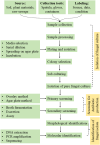Analyzing the Challenges and Opportunities Associated With Harnessing New Antibiotics From the Fungal Microbiome
- PMID: 40698515
- PMCID: PMC12284604
- DOI: 10.1002/mbo3.70034
Analyzing the Challenges and Opportunities Associated With Harnessing New Antibiotics From the Fungal Microbiome
Abstract
The rapid rise in antibiotic resistance is a critical global health issue, and few new classes of antibiotics have been discovered since 1990 compared to the antibiotic's golden era between 1950 and 1970. However, developing new antimicrobial compounds faces many challenges, improvements in cultivation methods, genetic engineering, and advanced technologies are opening new paths for discovering and producing effective antibiotics. This study focuses on the fungal microbiome as a promising source of new antibiotics. We explored historical developments and advanced genetic techniques to reveal the potential of fungi in antibiotic production. Although isolating and scaling up fungal antibiotic production presents challenges, innovative approaches like in situ separation during fermentation can effectively address these issues. Our research highlights the importance of understanding fungal communication and metabolite sharing to enhance antibiotic yields and the connection of cutting-edge technologies in accelerating the discovery and optimization of antibiotic-producing fungi. By focusing on these technical aspects and fostering teamwork across various fields, this study aims to overcome current obstacles, and advance the development of antibiotic production technologies.
Keywords: antibiotic discovery; fungal metabolite sharing; fungal microbiome; fungal–bacterial interactions; industrial‐scale processes of antibiotics.
© 2025 The Author(s). MicrobiologyOpen published by John Wiley & Sons Ltd.
Conflict of interest statement
The authors declare no conflicts of interest.
Figures





Similar articles
-
A tale of two vineyards: parsing site-specific differences in bacterial and fungal communities of wine grapes from proximal vineyards and their changes during processing in a single winery.Appl Environ Microbiol. 2025 Jun 18;91(6):e0052625. doi: 10.1128/aem.00526-25. Epub 2025 May 5. Appl Environ Microbiol. 2025. PMID: 40323100 Free PMC article.
-
Machine learning models reveal Saccharomyces yeasts are associated with poor piglet growth in early development.J Anim Sci. 2025 Jan 4;103:skaf133. doi: 10.1093/jas/skaf133. J Anim Sci. 2025. PMID: 40296223
-
AI-Driven Antimicrobial Peptide Discovery: Mining and Generation.Acc Chem Res. 2025 Jun 17;58(12):1831-1846. doi: 10.1021/acs.accounts.0c00594. Epub 2025 Jun 3. Acc Chem Res. 2025. PMID: 40459283 Free PMC article. Review.
-
Landscape-scale endophytic community analyses in replicated grapevine stands reveal that dieback disease is unlikely to be caused by specific fungal communities.Appl Environ Microbiol. 2025 Jul 23;91(7):e0078225. doi: 10.1128/aem.00782-25. Epub 2025 Jun 20. Appl Environ Microbiol. 2025. PMID: 40539779 Free PMC article.
-
Antibiotics for community-acquired pneumonia in adult outpatients.Cochrane Database Syst Rev. 2014 Oct 9;2014(10):CD002109. doi: 10.1002/14651858.CD002109.pub4. Cochrane Database Syst Rev. 2014. PMID: 25300166 Free PMC article.
References
-
- Agarwal, C. 2023. A Review: CRISPR/Cas12‐Mediated Genome Editing in Fungal Cells: Advancements, Mechanisms, and Future Directions in Plant‐Fungal Pathology. ScienceOpen. 10.14293/PR2199.000129.V2. - DOI
-
- Agrawal, S. , Dufossé L., and Deshmukh S. K.. 2023. “Antibacterial Metabolites From an Unexplored Strain of Marine Fungi Emericellopsis minima and Determination of the Probable Mode of Action Against Staphylococcus aureus and Methicillin‐Resistant S. aureus .” Biotechnology and Applied Biochemistry 70, no. 1: 120–129. 10.1002/bab.2334. - DOI - PubMed
Publication types
MeSH terms
Substances
Grants and funding
LinkOut - more resources
Full Text Sources
Medical

